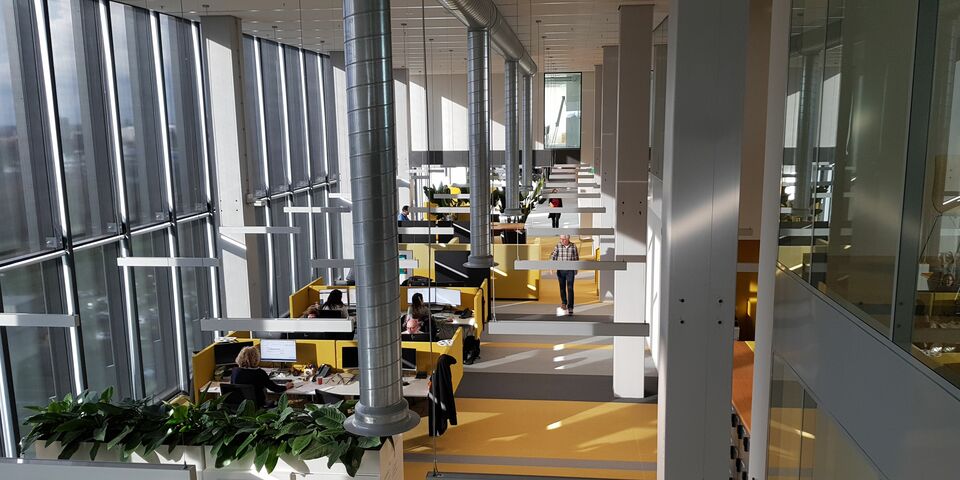Prof Talk | Racket in open-plan offices
Desk ‘islands’ supposedly facilitate consultation, enhance knowledge sharing, and boost creativity. But according to television program De Monitor, employees are increasingly complaining about the open-plan office; complaints about noise nuisance, fatigue and burn-out. Indoor environment expert Marcel Loomans and corporate real estate expert Rianne Appel see no reason to abolish open-plan offices, they would however like employees to have more influence on the design of their workplace, and they are in favor of behavioral guidance. Health & Safety expert David van de Koppel discusses the effects of the open-plan office in Atlas on staff members in that building.
More and more organizations have one: an open-plan office. Sitting together in one large, flexible space where it’s easy to consult. Sounds great, but it’s bad for your health, according to television program De Monitor (in Dutch only), which aired Monday last week.
According to the makers, their research showed that working in an open-plan office leads to less productivity and more sickness absence.
A large group of health & safety experts emphasized that employees are increasingly pointing to the open-plan office as the cause of complaints about fatigue, stress and burn-out. A podcast (in Dutch only) that accompanies the television program quickly brought some nuance though; the open-plan office perhaps isn’t the main cause of sickness absence, but it can aggravate these complaints.
Rianne Appel, Associate Professor in Corporate Real Estate and Workplace Management at the Department of the Built Environment at TU/e, is not surprised. According to Appel, who can also be heard in the podcast, “we live in a society that has become increasingly busy and we are surrounded by more and more outside stimuli. When you want to concentrate on your work but constantly hear fragments of telephone conversations, or colleagues consulting or catching up, it can soon become too much.”
Noise nuisance
Marcel Loomans, assistant professor in the group Building Performance in the Department of the Built Environment, agrees that noise nuisance in particular is the main culprit.
“When we look solely to indoor environment, we didn’t come across any major problems in terms of air quality. Offices usually have well-functioning ventilation systems, which is why the quality of air is often higher in offices than at home or in schools. Temperature, however, causes problems a bit more often. Person A might be very warm and might want to open a window, while person B on the other hand might be cold already. You can adjust to the situation by dressing differently, but not having complete freedom to set the ‘thermic comfort’ yourself can sometimes cause friction.”
But by far the most serious source of complaints is noise nuisance, Loomans says. “Colleagues talking over the telephone, people one floor up who can be heard because of the open architecture of a building. A cacophony of sounds that causes distraction. And you usually hardly see any noise reducing measures: partitions made of noise-reducing material, special floor covering, or more plants. A proper approach can prevent much misery.”
Headphones
Open-plan offices shouldn’t be thought of as a cheaper workplace; from a facility management point of view, organizations often put together as many people as they can on the smallest possible floor area. Investing in a more personalized work environment is very important, both researchers say. Appel: “You see more and more people now with noise cancellation headphones, but that means you’ve already lost the original goal of the open-plan office: more mutual communication. An open work environment is by no means a bad thing by definition. I don’t believe open-plan offices should be abolished; we need to do more to create a diverse environment.”
Appel emphasizes that more research is needed to determine how the workplace can optimally support the mental health of office employees. “Organizations often aren’t aware enough that for many employees, most of the work they do requires individual concentration. It’s still common to tell employees to ‘go work at home.’ We need to get rid of that and start looking for a balance between support of both communication and concentration.”
Organizations often aren’t aware enough that for many employees, most of the work they do requires individual concentration
In short, figuring out how we make sure that the work environment remains a healthy place for everyone. Loomans: “Employees like to have an influence on the design of their work environment, but also on the indoor environment conditions. A heated desk with adjustable temperature, extra air movement, adjustable lighting; we are expanding our research into how technology can be beneficial to employee wellbeing.”
Appel’s group will soon lead a multidisciplinary project in which researchers – Loomans is part of the consortium as well – will investigate, together with fourteen business companies, how these kinds of technological adjustments affect the mental health of employees, she says. “For example, we are currently conducting experiments with sound masking to reduce intelligibility in open-plan offices at ASML; we noticed that many of the engineers who are sensitive to outside stimuli find it more difficult to ignore surrounding noise.”
Guidance
Attention to the physical aspects is important, Loomans emphasizes, but there’s more going on in open-plan offices. “I have a small office now where I can close the door behind me when I want to, but I will soon have to share it with a colleague. That means we both need to adjust.” “Better guidance,” says Appel. According to her, that would solve many of the open-plan office related complaints. “When employees have to switch over to an open-plan office, they often assume that it will not work out. That causes stress even before they actually sit down behind a desk in an open-plan office. We also see that people try to continue with their old behavior in the new environment. That doesn’t match, which leads to more stress caused by the change than is necessary. That’s why I propose that we teach people how to deal with their new work environment. Social aspects are truly underestimated.”
Appel points to a study from Sweden that showed that employees find it difficult to look for a special area to do work that demands concentration because they don’t want to move away from the group. “They fear that people will talk about them or that information might not be shared with them. And how do you bring up the issue of nuisance? One of our own studies showed that older employees and women are more likely to say something about this, but for the most part people tend to avoid the issue. Clear rules and some behavioral guidance will provide employees with more certainty, and as a result the feared ‘office jungle’ will be much less frightening.”
No peak in sickness absence
According to David van de Koppel, Health & Safety expert at TU/e and working at Arbo Unie, bringing together practically every support service member in an open-plan office on the top floors of Atlas has not led to a peak in sickness absence. “I haven’t seen that in the year during which the services were housed in this way. A few people, about two or three, did stop by to see me. They had problems with certain wellbeing aspects caused by the open-plan office. I try to find the exact cause or causes together with them, and come up with specific solutions. We’ve called in the help of a specialist in the field of workplace hygiene, for example.”
Van de Koppel is also in favor of adding a few extra silent spaces on both floors. “But I also see that managers of services look for customized solutions for their employers. For example, earlier this week, I spoke to the Financial and Economic Affairs department to discuss their possibilities. More desks to work on different levels, high and low, moving people who have more difficulty dealing with surrounding noise to a quieter area, and placing partitions. So, really looking for specific solutions together.”
There is no such thing as an ideal office, Van de Koppel says, “people are too different for that, for example when it comes to how they experience temperature. That is why a custom-made approach is so important. In addition, I see people wrestling with the loss of the autonomous control of their work environment. And to be honest, because I also have my working space in Atlas, when the blinds go up and down again three times in one hour where I’m sitting, I also start to ask questions. But that system has been shut down by now”.




Discussion